
Mr. Chan
Leave a message
Mr. Chan
Leave a messageInjection moulding is a manufacturing process used universally to manufacture various everyday goods. The majority of mass-produced products contain plastic injection moulded components including furniture fixings, plastic cutlery, CCTV cameras, games consoles, toasters, and vacuum cleaners.
The price of injection moulding varies with every project. Due to the initial upfront cost of the mould and tooling, the greater the number of parts being produced, the lower the overall unit costs. This is because tooling costs can be absorbed across more parts. Mass-produced parts often use injection moulding as it is the most economical and timely way to produce plastic parts at high volumes.
From a narrow point of view, this answer is good, but if it is only this, then in addition to cutting corners and tax evasion, is there any way to control or reduce costs?
There are several main cost drivers with injection moulding projects. Consequently, there are methods and best practices you can apply to reduce the costs of injection moulding for a more cost-effective solution whilst still providing excellent results.
Larger production runs can be beneficial in that they can benefit from economies of scale which reduce unit costs. However, depending on budgets and requirements, larger production runs may not be suitable as they often result in surplus stock and waste. If you are looking for further ways to reduce costs in your injection moulding project, this guide analyses injection moulding costs and offers solutions and ways to save money throughout the injection moulding process.
Injection moulding costs are determined by various factors, including:
Mold Designs
product design
Modify Molds
Material selection
Multi-Cavity Mold
Cycle Time

Privacy statement: Your privacy is very important to Us. Our company promises not to disclose your personal information to any external company with out your explicit permission.